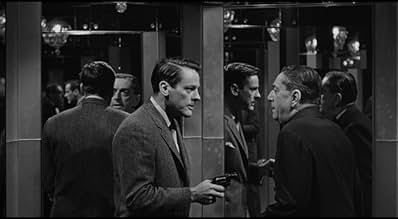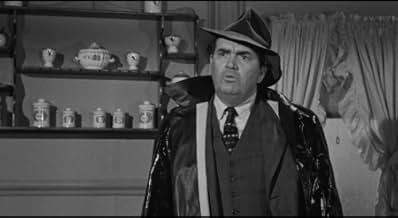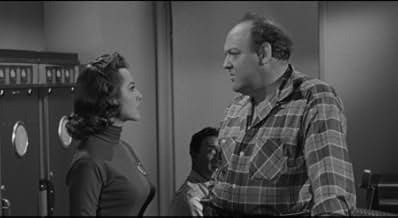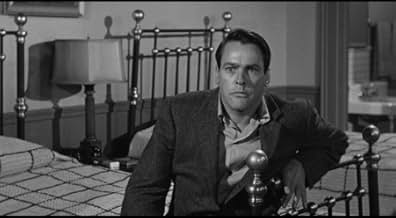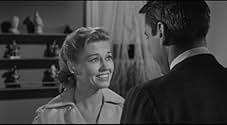IMDb RATING
6.4/10
1.4K
YOUR RATING
A New Orleans musician has a nightmare about killing a man in a strange house but he suspects that it really happened.A New Orleans musician has a nightmare about killing a man in a strange house but he suspects that it really happened.A New Orleans musician has a nightmare about killing a man in a strange house but he suspects that it really happened.
- Director
- Writers
- Stars
Ralph Brooks
- Oscar - the Bartender
- (uncredited)
Jack Chefe
- Nightclub Waiter
- (uncredited)
John Mitchum
- Onlooker at Stan's Suicide Attempt
- (uncredited)
Cosmo Sardo
- Nightclub Patron
- (uncredited)
- Director
- Writers
- All cast & crew
- Production, box office & more at IMDbPro
Featured reviews
Maxwell Shane remakes his own 1947 film Fear in the Night but with a better known cast and more money. Adapted from Cornell Woolrich's novel, story has Stan Grayson (Kevin McCarthy) as a New Orleans clarinetist who dreams he has committed a murder in a heavily mirrored room. Upon waking he finds clues that suggest he actually may have killed a man and frantically turns to his police detective brother-in-law, Rene Bressard (Edward G. Robinson), for help. But it doesn't look good for Stan...
Fear in the Night is a good film, and so is this, but if you have seen the earlier version then this feels very much perfunctory. The opening titles are superb, as melted candle wax plays host to the roll call shown in moody dissolves. We jump into Grayson's dream, again this is very well constructed on noirish terms, and from there on in it's a competently crafted visual film noir picture with good tension and splendid jazzy interludes.
However, nothing else makes it stand out, it just sort of exists as an exercise in late noir cycle film making, a pic that doesn't want to even try to push boundaries. The cast are dependable in performances, but nothing to really grab the attention, though Shane does work near wonders to cloak the characters in various levels of paranoia or suspicious machinations. New Orleans locales are a bonus, with cinematographer Joseph Biroc excelling at sweaty close-ups and the utilisation of shadows as foreboding presence's.
It all resolves itself in a haze of improbability, but as most film noir fans will tell you, that's actually OK. Yet this is still a film that's far from essential viewing for the like minded noir crowd. More so if you happened to have seen the 1947 version first. 6/10
Fear in the Night is a good film, and so is this, but if you have seen the earlier version then this feels very much perfunctory. The opening titles are superb, as melted candle wax plays host to the roll call shown in moody dissolves. We jump into Grayson's dream, again this is very well constructed on noirish terms, and from there on in it's a competently crafted visual film noir picture with good tension and splendid jazzy interludes.
However, nothing else makes it stand out, it just sort of exists as an exercise in late noir cycle film making, a pic that doesn't want to even try to push boundaries. The cast are dependable in performances, but nothing to really grab the attention, though Shane does work near wonders to cloak the characters in various levels of paranoia or suspicious machinations. New Orleans locales are a bonus, with cinematographer Joseph Biroc excelling at sweaty close-ups and the utilisation of shadows as foreboding presence's.
It all resolves itself in a haze of improbability, but as most film noir fans will tell you, that's actually OK. Yet this is still a film that's far from essential viewing for the like minded noir crowd. More so if you happened to have seen the 1947 version first. 6/10
I had a feeling of deja vu as I watched this, and I soon realized it was a remake of Fear in the Night, a 1947 film starring DeForrest Kelley.
This film stars Edward G. Robinson, Kevin McCarthy, Virginia Christine, Connie Russell.
A young New Orleans jazz musician Stan (McCarthy) dreams that he's involved in a murder. He wakes up holding a button, a key, and he has blood on him. He's convinced he committed murder without realizing it. He approaches his brother-in-law Rene (Robinson), a police detective, who brushes it off as a nightmare.
One day, while on a picnic, Stan, Rene, Rene's wife (Christine) and Stan's girlfriend Gina (Russell) are caught in a rainstorm. Without realizing how he knows, Stan directs them to a house. There's a mirrored room as in his dream, and the key fits a closet.
Rene realizes that somehow Stan was involved and accuses him of lying and demanding to know the whole story. Stan swears it was all a dream, and he doesn't know what happened. When the sheriff comes along and tells them there was a murder in the house, Rene wants more information, believing Stan is a killer.
Neat story by Cornell Woolrich, who wrote "Rear Window." Edward G. Robinson is great as always as a man determined to get to the bottom of the mystery.
Kevin McCarthy, who worked until he died at 96, is adorable in this.
Some fantastic singing by Connie Russell -- it's worth watching the film just to hear her -- in what would be her last film. After a long career on stage, films, and clubs on two continents, she retired when she became a mom.
Very entertaining. The end is wonderful, and really puts it a cut above "Fear in the Night."
This film stars Edward G. Robinson, Kevin McCarthy, Virginia Christine, Connie Russell.
A young New Orleans jazz musician Stan (McCarthy) dreams that he's involved in a murder. He wakes up holding a button, a key, and he has blood on him. He's convinced he committed murder without realizing it. He approaches his brother-in-law Rene (Robinson), a police detective, who brushes it off as a nightmare.
One day, while on a picnic, Stan, Rene, Rene's wife (Christine) and Stan's girlfriend Gina (Russell) are caught in a rainstorm. Without realizing how he knows, Stan directs them to a house. There's a mirrored room as in his dream, and the key fits a closet.
Rene realizes that somehow Stan was involved and accuses him of lying and demanding to know the whole story. Stan swears it was all a dream, and he doesn't know what happened. When the sheriff comes along and tells them there was a murder in the house, Rene wants more information, believing Stan is a killer.
Neat story by Cornell Woolrich, who wrote "Rear Window." Edward G. Robinson is great as always as a man determined to get to the bottom of the mystery.
Kevin McCarthy, who worked until he died at 96, is adorable in this.
Some fantastic singing by Connie Russell -- it's worth watching the film just to hear her -- in what would be her last film. After a long career on stage, films, and clubs on two continents, she retired when she became a mom.
Very entertaining. The end is wonderful, and really puts it a cut above "Fear in the Night."
******SPOILERS****** Unbelievably heavy handed movie that telegraphs it's story to the audience so directly that you think it's a commercial for Western Union. Musician Stan Grayson, Kevin McCarthy, walks around most of the time in a zombie-like induced state and when he's conscious with his eyes bulging out of his head and looking like he's going into cardiac arrest at any moment that you want to run to the nearest phone and call 911 for help.
Waking up one morning at his room at the Hotel New Orleans from a nightmare that he had about him being a hall of mirrors and getting into a fight where he kills someone in self-defense Stan then opens a door and falls into a dark and bottomless pit. Stan looks in the mirror and sees marks on his throat and blood on his arm as well as having both a key and a button from the man's suit that was in his dream.
The movie tries to be both hip and cool when it comes to Stan's mental state and how it was manipulated by the killer Dr. Belknap/Harry Britten, Gage Clarke, in a pseudo/psychological manner that was very common in films about mental issues back in the 1940's and 50's but seeing it now it comes across as both silly and amateurish.
The movie also tries to make a big deal about the killer being a doctor who is an expert in psychological studies just by judging from the books that he has in his private library, but at the same time make him physically violent. He runs over his wife with a car and shoots it out with the police in order to kill him off at the end of the movie.
Edward G.Robinson, Det. Rene Bressard, is very good in the movie as Stan's brother in-law and New Orleans police detective. Rene at first suspects Stan of the murders but then, like a good detective should, when he sees where the evidence leads him realizes that there is more to the murders then what he at first thought.
Kevin McCarthy seems to overact in the movie, or better yet was over-directed, by passing out about a half dozen times and coming across as being brain-dead even when he wasn't under hypnosis. The movie tells the audience that you can't do anything under hypnosis that you won't do when your conscious like murder at the same time we see Stan being told to drown himself in the swamp by Dr. Belknap and then willingly do it.
Granted Stan tried to kill himself earlier in the film by jumping from the fifteen floor of the Hotel New Orleans but that was when he thought that he was a murderer. By the time he was told to drown himself he already knew that he didn't commit any murders so there was no conscious or subconscious reasons for him to do it. Stan was eventually saved from drowning by his brother in-law Rene.
Virginia Christine, Sue Bressard, was very good as Stan's sister and Rene's pregnant wife who developed a hearty appetite because of the condition that she was in and Gage Clarke, Dr. Belknap/ Harry Britten, was effective as the highly educated murderer. Connie Russell, Gina, as Stan's love interest had really nothing to do in the movie but stand around and look pretty, she did sing two songs.
The movie "Nightmare" can be forgiven for it's heavy handedness since it was the norm in movies about psychiatric issues back in those days, 1955, but at the same time can't be taken seriously by anyone watching it now in 2004.
Waking up one morning at his room at the Hotel New Orleans from a nightmare that he had about him being a hall of mirrors and getting into a fight where he kills someone in self-defense Stan then opens a door and falls into a dark and bottomless pit. Stan looks in the mirror and sees marks on his throat and blood on his arm as well as having both a key and a button from the man's suit that was in his dream.
The movie tries to be both hip and cool when it comes to Stan's mental state and how it was manipulated by the killer Dr. Belknap/Harry Britten, Gage Clarke, in a pseudo/psychological manner that was very common in films about mental issues back in the 1940's and 50's but seeing it now it comes across as both silly and amateurish.
The movie also tries to make a big deal about the killer being a doctor who is an expert in psychological studies just by judging from the books that he has in his private library, but at the same time make him physically violent. He runs over his wife with a car and shoots it out with the police in order to kill him off at the end of the movie.
Edward G.Robinson, Det. Rene Bressard, is very good in the movie as Stan's brother in-law and New Orleans police detective. Rene at first suspects Stan of the murders but then, like a good detective should, when he sees where the evidence leads him realizes that there is more to the murders then what he at first thought.
Kevin McCarthy seems to overact in the movie, or better yet was over-directed, by passing out about a half dozen times and coming across as being brain-dead even when he wasn't under hypnosis. The movie tells the audience that you can't do anything under hypnosis that you won't do when your conscious like murder at the same time we see Stan being told to drown himself in the swamp by Dr. Belknap and then willingly do it.
Granted Stan tried to kill himself earlier in the film by jumping from the fifteen floor of the Hotel New Orleans but that was when he thought that he was a murderer. By the time he was told to drown himself he already knew that he didn't commit any murders so there was no conscious or subconscious reasons for him to do it. Stan was eventually saved from drowning by his brother in-law Rene.
Virginia Christine, Sue Bressard, was very good as Stan's sister and Rene's pregnant wife who developed a hearty appetite because of the condition that she was in and Gage Clarke, Dr. Belknap/ Harry Britten, was effective as the highly educated murderer. Connie Russell, Gina, as Stan's love interest had really nothing to do in the movie but stand around and look pretty, she did sing two songs.
The movie "Nightmare" can be forgiven for it's heavy handedness since it was the norm in movies about psychiatric issues back in those days, 1955, but at the same time can't be taken seriously by anyone watching it now in 2004.
This One has an Interesting Pedigree.
It is a Remake of a Film-Noir, Fear in the Night (1946) from the same Director, the Prolific (mostly screenplays) Maxwell Shane. Everybody Endlessly compares the two Movies,
This is a Distinctive Noir, at the End of the Cycle and it is Remarkable because it includes almost every Film-Noir Trope starting with the Title. Obsessive Fans of the Genre could make a List.
The least Impressive thing about "Nightmare" is the Print. TCM, a stickler for finding the Best Available, showed a very Unimpressive Version that was Weak all around. The Contrast is "Grayish" and the Look is very Flat. That Visual Disappointment Aside, the Film reminds of the Great Style that was all but Forgotten by 1956.
Seemingly Filmed on a Very Low Budget, it still manages to Conjure Up the Atmosphere of True Film-Noir. The On-Location Footage on the Streets and Bayou are "Nightmarish". The Film feels Odd and Off-Beat adding to the Enjoyment.
The Cast lead by Edward G. Robinson and Kevin Mccarthy give the Movie Gravitas and the Story, by Cornell Woolrich, is Rich with Mysterious Happenings and Dreamlike Displays.
If every Reviewer on Earth hasn't Spoiled the Ending You will Undoubtedly have a Fun Time with this Mystery Movie.
Highly Recommended for Low-Budget Entertainment.
This 1956 Film-Noir shows just what Staying Power the Genre could Generate. The Conservative Fifties, with Very Few Exceptions, had Hollywood Capitulating to Government Gawking and Back-Room Intimidation and the Cynical and Edgy Film-Noir Genre was Relegated to Cheap Second Features and within a Year or two was Abandoned Altogether.
Making a Comeback about Later, as Neo-Noir, the Movies Started Experimenting with a Renewed Energy as things were Opening Up Culturally and the Art Form found that the Freedom to Express was again winning the Public's Imagination and Imagination is obviously one of the Ingredients in the Creative Process.
It is a Remake of a Film-Noir, Fear in the Night (1946) from the same Director, the Prolific (mostly screenplays) Maxwell Shane. Everybody Endlessly compares the two Movies,
This is a Distinctive Noir, at the End of the Cycle and it is Remarkable because it includes almost every Film-Noir Trope starting with the Title. Obsessive Fans of the Genre could make a List.
The least Impressive thing about "Nightmare" is the Print. TCM, a stickler for finding the Best Available, showed a very Unimpressive Version that was Weak all around. The Contrast is "Grayish" and the Look is very Flat. That Visual Disappointment Aside, the Film reminds of the Great Style that was all but Forgotten by 1956.
Seemingly Filmed on a Very Low Budget, it still manages to Conjure Up the Atmosphere of True Film-Noir. The On-Location Footage on the Streets and Bayou are "Nightmarish". The Film feels Odd and Off-Beat adding to the Enjoyment.
The Cast lead by Edward G. Robinson and Kevin Mccarthy give the Movie Gravitas and the Story, by Cornell Woolrich, is Rich with Mysterious Happenings and Dreamlike Displays.
If every Reviewer on Earth hasn't Spoiled the Ending You will Undoubtedly have a Fun Time with this Mystery Movie.
Highly Recommended for Low-Budget Entertainment.
This 1956 Film-Noir shows just what Staying Power the Genre could Generate. The Conservative Fifties, with Very Few Exceptions, had Hollywood Capitulating to Government Gawking and Back-Room Intimidation and the Cynical and Edgy Film-Noir Genre was Relegated to Cheap Second Features and within a Year or two was Abandoned Altogether.
Making a Comeback about Later, as Neo-Noir, the Movies Started Experimenting with a Renewed Energy as things were Opening Up Culturally and the Art Form found that the Freedom to Express was again winning the Public's Imagination and Imagination is obviously one of the Ingredients in the Creative Process.
Kevin McCarthy stars as a musician who wakes up one morning to find tangible evidence of something he thought he'd done in a dream. Things really gets going when good old Edward G. Robinson appears as the musician's brother-in-law who also just happens to be a police detective. There's just something about Eddie G. that compels us to watch him, whatever he's in.
McCarthy's character, Stan, thinks he may have committed a murder, and is tortured by the fact that he has no recollection of doing so, except in his "nightmare".He can't reconcile what he knows as reality with what he remembers from his dream and the evidence he found afterwards. (Intriguingly, a button and an odd-looking key.)
Oh, there's also a few female characters, none of them of the fatale variety. One of them is just a pick-up in a seedy all-night bar (interesting and kind of fun scene, though), the other two are his sister and his "girlfriend". I put girlfriend in quotation marks because Stan doesn't seem to have much regard for the poor girl, who's a jazz singer and devoted to him. Poor Gina, Stan has not the least interest in confiding his troubles to her, or in fact talking to her at all, as far as I could tell. He's always telling her he'll get back to her later, when he's straightened some things out.
Some noirs have a smart and sympathetic girlfriend or secretary (who of course later becomes the girlfriend) who helps the main character sort out his troubles, but Nightmare isn't one of those. It's all about Edward G. and his crime-solving abilities. But who's complaining when Edward G. solves or even commits a crime in any movie?
The story is set and filmed on location in New Orleans, which is a major strength of the film. There's one scene where Stan goes on a desperate search through the nightclubs and all-night bars of the city, trying to find a musician who's heard the mysterious melody he heard in his nightmare. I love all the neon lights flashing on and off, proclaiming the alluring names of the nightclubs - scenes like this are what noir is made of.
Another memorable scene is when Stan, the long-suffering Gina, and Edward G.Robinson and his wife (Stan's sister) go on a picnic and get caught in a rainstorm. They take refuge in a deserted house, where they light a fire and make themselves tea ! It just struck me as funny that they were making themselves so much at home in a complete stranger's house. Now, there is a reason for this, but that would be spoiler territory.
McCarthy's character, Stan, thinks he may have committed a murder, and is tortured by the fact that he has no recollection of doing so, except in his "nightmare".He can't reconcile what he knows as reality with what he remembers from his dream and the evidence he found afterwards. (Intriguingly, a button and an odd-looking key.)
Oh, there's also a few female characters, none of them of the fatale variety. One of them is just a pick-up in a seedy all-night bar (interesting and kind of fun scene, though), the other two are his sister and his "girlfriend". I put girlfriend in quotation marks because Stan doesn't seem to have much regard for the poor girl, who's a jazz singer and devoted to him. Poor Gina, Stan has not the least interest in confiding his troubles to her, or in fact talking to her at all, as far as I could tell. He's always telling her he'll get back to her later, when he's straightened some things out.
Some noirs have a smart and sympathetic girlfriend or secretary (who of course later becomes the girlfriend) who helps the main character sort out his troubles, but Nightmare isn't one of those. It's all about Edward G. and his crime-solving abilities. But who's complaining when Edward G. solves or even commits a crime in any movie?
The story is set and filmed on location in New Orleans, which is a major strength of the film. There's one scene where Stan goes on a desperate search through the nightclubs and all-night bars of the city, trying to find a musician who's heard the mysterious melody he heard in his nightmare. I love all the neon lights flashing on and off, proclaiming the alluring names of the nightclubs - scenes like this are what noir is made of.
Another memorable scene is when Stan, the long-suffering Gina, and Edward G.Robinson and his wife (Stan's sister) go on a picnic and get caught in a rainstorm. They take refuge in a deserted house, where they light a fire and make themselves tea ! It just struck me as funny that they were making themselves so much at home in a complete stranger's house. Now, there is a reason for this, but that would be spoiler territory.
Did you know
- TriviaWhen Stan goes out walking the morning after his nightmare, he passes by a place with a sign that says "New Orleans' Most Famous Coffee Drinking Place." That would be the Morning Call Coffee Stand that was on Decatur Street in the French Quarter. Opened in 1870, it moved to Metairie in 1974.
- GoofsAccording to the elevator there are only 15 floors in the hotel, but the shot of the building from outside shows more than fifteen.
- Quotes
[first lines]
Stan Grayson: At first, all I could see was this face, this beautiful babe's face, floating toward me. And in my head, was this slow, crazy melody - like a tune from another world. And then a I saw the room - a queer mirrored room. And somehow, I was inside of it. There was danger there. I knew that.
- ConnectionsFeatured in Out of this World Super Shock Show (2007)
- SoundtracksWhat's Your Sad Story
Words and Music by Richard M. Sherman (as Dick Sherman)
Performed by Connie Russell / Billy May Orchestra
- How long is Nightmare?Powered by Alexa
Details
- Runtime1 hour 29 minutes
- Color
Contribute to this page
Suggest an edit or add missing content



